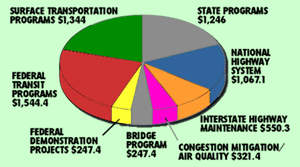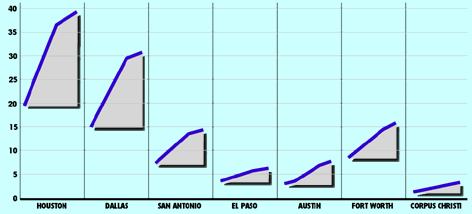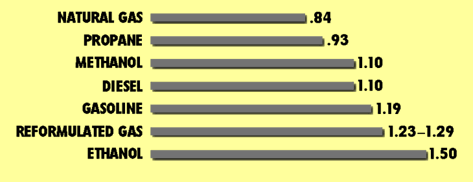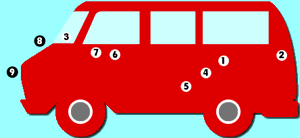

Almanac Table of Contents | Chapter Six Table of Contents | TEC Home Page
NEXT PAGE * PREVIOUS PAGE Go to page 1*2*3*4*5*6*7*8*Notes

Today's automobile produces approximately 90 percent less pollution than cars built in the 1960s.(82) Leaded gasoline has been phased out, and government-mandated manufacturing improvements, like the catalytic converter and the fuel injector, have significantly reduced tailpipe emissions. However, the benefits of these improvements have been largely offset by several factors: a rapid expansion in the number of cars on the roads, an increase in the number of miles driven each day and changes in the composition of gasoline. (As lead has been phased out, refineries have made up for the loss in octane with changes in the gasoline formula that make auto fuel more likely to release smog-forming VOCs into the air.(83)) As a result, motor vehicle use still contributes significantly to air pollution, accounting for a quarter of the CFCs in the air, 70 percent of the carbon monoxide and more than a third of volatile organic compounds and nitrogen oxides emitted in the United States.(84)
In Texas, vehicles also account for 24 percent of all air toxics, and most of the air-borne cancer-causing compounds like butadiene and benzene.(85) When toxic emissions from service stations, auto body shops and the gasoline refinery and tire manufacturing industries are added in, motor vehicles' contribution to toxic emissions in Texas climbs to 45 percent.(86)
There are three obvious ways to reduce pollution from cars: produce lower-emission vehicles, reduce the number of vehicle miles traveled and convert vehicles to cleaner, alternative fuels like natural gas, propane and electricity.
The Federal Clean Air Act requires states to develop a plan to bring non-attainment areas into compliance with national air quality standards. These plans must include a mobile sources component. The Texas Natural Resource Conservation Commission has submitted a plan to the Environmental Protection Agency for the state's four ozone non-attainment areas: El Paso, Houston/Galveston/Brazoria, Dallas/Fort Worth and Beaumont/Port Arthur.
| NEW HIGHWAY VEHICLE PROGRAMS MANDATED BY CLEAN AIR ACT OF 1990 - INCLUDED IN TEXAS' STATE IMPLEMENTATION PLAN. |
|---|
|
REFORMULATED FUEL: Houston/Galveston/Brazoria. Use fuels that are 15 percent cleaner (1995). Use fuels that are 25 percent cleaner (2000). Fuel distributors must sell gasoline that has been reformulated to produce lower hydrocarbon emissions, increasing fuel costs by 3 to 5 cents per gallon in affected areas.
OXYGENATED FUEL: El Paso. Use fuels with 2.7 percent oxygen content during "high CO" season (1992). Gasoline sold between October 1 and March 31 must have a minimum oxygen content of 2.7 percent. El Paso's program has reduced carbon monoxide emissions by 17 percent with minimal effect on fuel prices. TEXAS ALTERNATIVE FUEL FLEET PROGRAM: Non-attainment areas. A percentage of new vehicles in commercial fleets must meet clean-fueled vehicle standards (30 percent by 1998, 50 percent-1999, 70 percent-2000). Applies to private/commercial and government fleets with 15 or more vehicles. Alternative fuels may include CNG, LNG, ethanol, methanol or electric. Legislation has expanded this to any fuel that can be used to meet the standards, including reformulated fuels. VEHICLE INSPECTION AND MAINTENANCE: Non-attainment areas. High-tech emissions testing, evaporative system checks (General public, 1995). Applies to all gasoline powered vehicles registered or operating in the non-attainment areas. Odd model year vehicles test in odd years, even model in even years. Legislation allowing the Governor to negotiate greater consumer convenience and flexibility has recently passed. EMPLOYER TRIP REDUCTION: Houston. Employers must adopt plans to reduce work-related trips by 25 percent (Submit plans, 1994; compliance, 1996) Program modifications are being considered to provide market-based incentives and minimize employer compliance liability. Source: Texas Natural Resource Conservation Commission. |
TIGHTER TAILPIPE EMISSION STANDARDS
Cutting emissions from auto tailpipes may be the most direct method to reduce air pollution. The Pechan Study, sponsored by the Northeastern States for Coordinated Air Use Management, concluded that cutting emissions from mobile sources is more economical than reducing emissions from industry. Of course this relationship does not hold for all industries and all areas. But in areas of Texas where mobile sources contribute significantly more VOCs and nitrogen oxides to the atmosphere than industries do, reducing vehicle emissions may be the most economical way to fight urban pollution.(87)
Source: Sam Howe Verhovek, "Texas Joins Parade of States Colliding with Clean Air Act," The New York Times, February 14, 1995.
Under the 1990 Federal Clean Air Act, pollution-control equipment (fuel injectors and catalytic converters) on all 1994 cars must last for 100,000 miles, rather than the 50,000 miles required by previous Federal Clean Air Acts. In addition, engines for diesel trucks must be designed to reduce particulate releases by 90 percent. Buses will have to make similar reductions. Finally, the Act requires the automobile industry to produce vehicles that emit 35 to 50 percent less VOCs, nitrogen oxides and carbon dioxide than current vehicles.(88) At least 500,000 of these Low Emission Vehicles (LEVs) must be manufactured for sale in California by 1999.(89) New Jersey, New York, Pennsylvania, Massachusetts and Maine are considering requiring the sale of these vehicles to meet ozone standards.
New regulations adopted by the Texas Natural Resource Conservation Commission require that, beginning September 1998, an increasing percentage of all vehicles bought or leased by all mass transit and all other fleets with 15 or more vehicles must meet or exceed the LEV tailpipe emissions standards. By 2002, 90 percent of all new vehicle purchases must meet these standards. The program affects all private and public fleets in three non-attainment areas: El Paso, Houston/Galveston/Brazoria and Beaumont/Port Arthur. To meet these standards, vehicles can either use alternative fuels such as propane, natural gas, ethanol, methanol, or electricity, reformulated gasoline or diesel fuels.(90)

1994-1996 funds in millions
Source: Texas Department of Transportation, as reported in Texas Comptroller of Public Accounts, Fiscal Notes, February 1994..
An alternative measure that would directly reduce vehicle emissions would be to reduce the number of vehicles driven and miles traveled. In the 1980s, urban traffic grew more than roadway capacity throughout the country, leading to congested traffic. The traditional response to traffic congestion has been to build more highways. But this expansion inevitably provides an incentive for more people to drive cars and encourages increases in vehicle miles traveled.
Source:Texas Comptroller of Public Accounts, Fiscal Notes, February 1994, 3.
Both the 1990 Federal Clean Air Act and the 1991 Intermodal Surface Transportation Efficiency Act (ISTEA) have emphasized transportation planning that encourages car-pooling and the use of public transportation. ISTEA, if fully funded, will funnel an additional $385 million in federal funds to Texas each year between 1992 and 1997. Moreover, the ISTEA-required planning process relies heavily on local Metropolitan Planning Organizations (MPOs) to help distribute these funds. Each MPO must certify that its use of federal funds will result in fewer emissions or better air quality.(91) Still, the Texas Department of Transportation estimates that only 5 percent of federal, state and local highway funds is being specifically earmarked to mitigate congestion and improve air quality.
Texas has more motor vehicles than any state except for California, and in Texas, as in the nation as a whole, the number of cars driven and miles traveled have grown exponentially in recent decades.(92) With more than 18 million cars registered to Texas drivers, traffic congestion has become a problem in cities all over Texas. Congestion causes travel delays and wastes fuel. It also decreases fuel efficiency and increases dangerous vehicle emissions. In Houston, traffic grew by 75 percent between 1970 and 1980. In 1990, Houston was among the 10 most congested cities in the U.S.(93) The TNRCC notes that increased traffic speeds monitored in recent years suggests congestion improvements.
Source: Hall and Kerr, 1991-1992 Green Index: A State-by-State Guide to the Nation's Environmental Health (Washington, DC: Island Press, 1991), 21.
The Federal Clean Air Act mandates an Employer Trip Reduction (ETR) Program in severe and extreme non-attainment areas. This program requires employers with more than 100 employees at a worksite to offer those employees incentives to stop driving to and from work alone. In Houston, total miles driven in commuting trips must be reduced and passenger occupancy increased by 25 percent through ETR efforts. The Legislature recently approved a six-month delay in the program to help make it more flexible.

Population growth and a continuing reliance on the automobile have caused a steady increase in the number of vehicle miles traveled on Texas' major urban roadway systems.
Source: Texas Transportation Institute as reported in Texas Comptroller of Public Accounts, Fiscal Notes, February, 1994, 1.
A third way to reduce pollution from cars is to change to cleaner-burning fuels. Recognizing Texas' vast potential as an "alternative energy" state, the Texas Legislature created its own "plan" for alternative fuels by passing legislation in 1989.(94) The legislation requires state agencies, school districts with more than 50 buses and all mass transit authorities to purchase only those new vehicles capable of running on alternative fuels. By September 1, 1994, state agencies and mass transit authorities must have converted 30 percent of their fleets to alternative fuel. By 1996, 50 percent must be converted and by 1998, 90 percent. School districts have a slightly more flexible schedule: by September 1, 1997, 50 percent of their buses must be converted and 90 percent must be using an approved alternative fuel by 2001. Private fleets of more than 15 vehicles in Houston/Galveston/Brazoria, El Paso and Beaumont/Port Arthur are subject to these same requirements as part of the state's plan to meet the Clean Air Act. By 1998, 30 percent of the vehicles are required to use alternative fuels.
The alternative fuels currently approved for use in Texas by the TNRCC are: natural gas, liquid petroleum gas (propane), methanol, ethanol and electricity. Industry groups and some legislators have proposed including both low-sulfur diesel and reformulated gasoline as alternative fuels. Under a revised plan not yet approved by the EPA, the TNRCC will allow use of these fuels for local governments, private fleets and smaller school districts providing they meet tough emission standards.(95) The certification of alternative-fueled vehicles to specific low emission vehicle standards is necessary to quantify emission reductions.
Alternative fuels have two advantages over conventional fuels: price and cleanliness. One disadvantage is that alternative-fuel vehicles cannot travel as far without refueling. For example, a gasoline-fueled vehicle able to travel 100 miles would only travel 85 miles on propane and 31 miles on Compressed Natural Gas (CNG) because the alternative fuels have lower energy content.(96) However, improvements in automobile manufacturing technologies are increasing gas mileage for propane, methanol and natural gas vehicles.
Source: Information provided by Alternative Fuels Division, Texas Railroad Commission, Alternative Fuels Research and Education Division.
New technology alternative-fueled vehicles can be substantially cleaner than today's gasoline-powered vehicles. Compressed natural gas (CNG)-powered vehicles are cleaner because they use a closed-loop system - there is no evaporation or escape of uncombusted gas before it reaches the tailpipe. A diesel-fueled bus emits as much particulate matter as 500 natural gasoline-powered automobiles.(97)
Propane - or Liquified Petroleum Gas (LPG) - is another cleaner burning alternative fuel. Like CNG, the fuel system in a propane-powered vehicle is a closed-loop system, meaning there are no evaporative emissions. In addition, propane-powered vehicles emit even less nitrogen oxides than vehicles using natural gas. Another significant advantage of both CNG and propane use is that both fuels eliminate the need for underground storage tanks. Texas has had nearly 15,000 reported cases of leaks from petroleum underground storage tanks - leaks that often contaminate soil and water.(98)
Several companies in Texas have been promoting electric vehicle (EV) technology. Electrosource, an Austin-based company, is developing a lead-acid electric battery that is expected to last 50,000 miles. The battery would also allow cars to travel between 100 and 150 miles before recharging.(99) The Chrysler Corporation plans to test the new electric battery on a fleet of mini-vans. Still, the limited number of miles these vehicles can travel before recharging and the time needed to recharge are obstacles to their widespread acceptance.
The conversion of vehicles to alternative fuels might be beneficial to the Texas economy, which sits atop 27.5 percent of known natural gas reserves in the continental U.S.(100) Initially viewed by the oil industry as a costly waste product, natural gas has now become an important source of energy in Texas and the world. Propane is the most widely used alternative fuel in Texas, the U.S. and the world, and Texas produces more propane than any other state. More than 60 percent of propane comes from natural gas production; the remainder is derived from crude oil during the refining process. Texas oil and natural gas refineries produced about 5.6 billion gallons of propane in 1992.(101)
Most propane is used as a raw material in the production process at petrochemical plants; however, about 10 percent is used for transportation fuel. Farmers and ranchers in Texas have long relied on propane to fuel agricultural vehicles and rural Texans have used it for heating and cooking for some 50 years.(102)
At present, the major obstacles to the use of alternative fuels is the lack of an infrastructure for distributing them to consumers, and a range limitation considering the distances between towns in West Texas and the Panhandle. Unlike regular gasoline or diesel fuels, there is not a CNG refueling station on every corner. As of April 1994, Texas had 73 filling stations for natural gas refueling and about 1,200 propane refueling stations.(103)
Another obstacle to the use of alternative fuels is the cost of converting old vehicles to run on an alternative fuel. The price tag for converting an average car to propane, which includes replacement of the fuel system and installation of new electronics, is about $2,000.(104) Ford officials have estimated that natural gas vehicles currently cost $3,500 to $6,000 more to manufacture than conventional vehicles. In 1983, the Garland Independent School District invested $241,000 to convert 65 school buses and 12 support vehicles to natural gas and to install refueling facilities. This expenditure aver-aged out to about $3,500 per vehicle. In general, it is cheaper to convert a vehicle to propane than to natural gas. Despite these conversions costs, converting vehicles may be economical for some fleets in the long run because propane and natural gas are cheaper than gasoline and because maintenance costs are generally lower over a 3- to 5-year period. The city of Garland saved more than $100,000 in the first two years alone in fuel and maintenance costs.(105)
Source: Julie Bonnin, "Fuel for Thought," Austin American Statesman, February 2 1993, F1.
Since alternative fuels legislation went into effect in 1991, about 80 percent of the vehicles that have converted to alternative fuels have converted to propane.(106) As of July, 1994, there were 30,453 alternative fuel vehicles registered with the Comptroller's Motor Fuel Tax Section. This total does not include several thousand alternative-fueled vehicles operated by counties and school districts, which are not taxed.(107) At present, 39 school districts are using propane to fuel their vehicles.(108)

1994 $ average price per gallon or gallon equivalent
Source: Texas Comptroller of Public Accounts, Fiscal Notes, Sept. 1994, 6.
| ENVIRONMENTAL BENEFITS OF COMPRESSED NATURAL GAS VEHICLES |
|---|
| Substitution of compressed natural gas for gasoline as a transportation fuel provides the following environmental benefits:
Source: Texas General Land Office, Putting Together the Pieces: The Recapitilization of the Texas Economy, (Austin: Texas General Land Office, January 1989), 24. |

Source: Lone Star Gas Company, Natural Gas Vehicles: The Decision Stops Here (Dallas: RP Publishing, 1994), 12.

NEXT PAGE * PREVIOUS PAGE Go to page 1*2*3*4*5*6*7*8*Notes

Please send questions, comments, or problems with this page to ltarver@mail.utexas.edu.